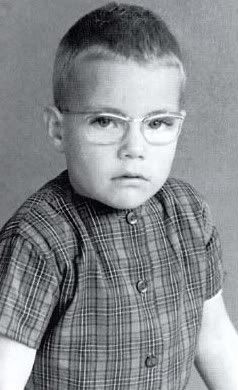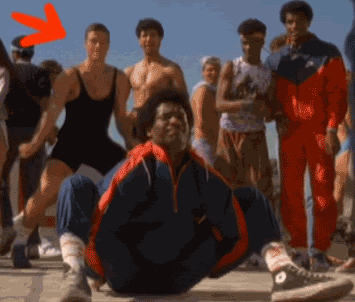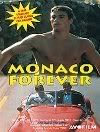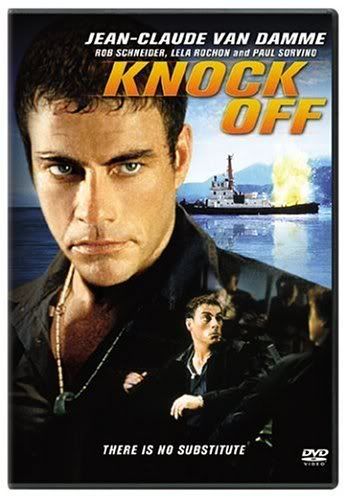The beginning of the “End Times” will be marked by the boiling of the seas and the raining of blood from the sky. Could it happen this Year? Maybe. It almost happened to me this past “New Year’s Eve” due to how much I had to drink. Apocalypse or not, though, I know that Geekscape will live on; and somehow because of that fact, everything doesn’t seem as bad – regardless of any horrible, apocalyptic outcome. In this History of the Nerd I want to celebrate the true inspiration behind Geekscape, the rock which all else revolves around. Jonathan London? Nope. Ben Dunny? Keep trying. Brian Gilmore? Please, get fuckin’ serious. The person I am speaking of is none other than Jean-Claude Van Damme.

Child Hood – From Flower Shops to Karate Chops.
On October 1960, Eliana Van Vaerenbergh’s water broke and a hero arrived into world – a hero destined to change the face of action entertainment. He was born Jean Claude Camille François Van Vaerenberg. Young Jean Claude’s lived a rather simple life in Berchem-Sainte-Agathe, a small municipality just outside of Brussels Belgium. His father, Eugène Van Vaerenbergh, was an accountant and the owner of a flower shop. Strangely enough growing up in a flower shop didn’t make him very manly.



Van Damme stated that he “grew up sadly as a skinny kid. Wearing big, thick, glasses and was very much a nerd.” A timid, shy and scared little kid that loved Beethoven way too much, Jean Claude couldn’t kick a ball, let alone someone’s balls. Eugène feared his son was too weak and that he might grow up “funny”, so he enrolled Jean Claude into Shotokan Karate at the age of 10 in 1971. Jean-Claude’s evolution from nerdy, crying, sad sack to an iron fist that could crush a skull in the palm of its hand should be an inspiration to us all. Hope is not lost for you out there, so stop all the book-wormy shit and take some karate and one day you too could get some ass, and also (if you want to) kick some ass as well.

At the age of 12, Jean Claude studied under the famed pioneer of European karate – Master Claude Goetz. Goetz trained Jean Claude for four years before he was allowed into a tournament. Four years of blood and sweat. Four years of honing his body into a fine instrument of physical mayhem. Four years and then…he almost got his shit handed to him.
Fighting Career – Everybody was Kung Fu fighting.
Jean-Claude’s fight debut was in 1976, Jean Claude was 16. The entire thing was a near failure. During an event sanctioned by the European Karate Union (EKU) in Brussels, Jean was badly stunned at the beginning of the match. Fellow countryman Toon Van Oostrum threw a crushing round-house kick and sent Jean Claude staggering about the ring. Jean Claude, the White Tiger of the West, came back to finish off Oostrum in less than 46 seconds. Maybe he even did that comeback scream he does in all his movies. Knockouts were not allowed for the match, so Oostrum eventually couldn’t take Van Damme’s heat and ended up quitting. The result was listed as “stoppage 0:46”. Even though Jean Claude won, his teacher and coach, Claude Goetz, thought he needed more training before allowing him to re-enter the ring – so Jean-Claude was forced to take ballet.


He would go on to study ballet for five years. He became so proficient in prancing, that he would be dubbed “The Balloon” for his high jumps. He was invited to join the Paris Opera as a dancer but he declined, favoring bashing people’s noses in with his bare fist. Male ballet dancers do, however, get a bad rap. I know men in tights look a little silly, but have you really looked at those dudes? They have legs like medieval cudgels and bodies toned to peak human conditions. They look like they could shatter every bone in a man’s body without even trying. Also just look at their sack! Try and tell me that bulge doesn’t look a little intimidating…but I digress.

Two years later, Jean Claude returned to the world of European Full-Contact Fighting. At this point, nobody was talking shit about his long-ass name or his ballet dancing. In Antwerp, Belgium he entered in his first EKU tournament in the Beginner’s Division. The two years of training gained the now 18 year old Jean Claude more confidence and skill, (also, all that ballet taught him how to do those awesome splits he’s always doing) allowing him to lay waste to his victims. That night he had 3 victories, an 18 second knockout over German-born, Eric “Basel” Strauss, a 39 second stoppage over Michel Juvillier, and a 12 second stoppage of Orlando Lang. These are 3 names nobody knows anything about and will never hear of again. They are just happy to have had their asses Van Dammed, so they can now be a footnote in history.
Over the course of his fighting career he would only be beaten once. In November, 1979 Master Goetz took his prize pupil to the United States to compete in the WAKO (World All-Styles Kickboxing Organization) World Full-Contact Championships in Tampa, Florida. Jean Claude was doing well. He defeated ‘Sherman ‘Big Train’ Bergman’ with a perfectly timed ax-kick and knocked Big Train out cold within 59 seconds of the first round. With a spinning back-fist he knocked out South American Gilberto Diaz in 13 seconds. Then, in the semi-finals, a fellow Belgian, Patrick Teugels, defeated Jean Claude in a 2-round decision. Perhaps it was over-confidence on Jean Claude’s part, perhaps he choked in the face of success; but even though he lost this match, Jean-Claude would go on to redeem himself.


In 1980 he was offered a minor role in a French film, Rue Barbare (Barbarian Streets). He played a police officer. This taste of fame and fortune without being pummeled by a steroid injected 300lb gorilla was too tempting to pass up. Jean Claude Camille François Van Varenberg re-focused his interest from karate to acting. In an October 1991 interview with Philippe Graton, author of Van Damme: An Anatomy of Determination, Jean-Claude was quoted as saying, “I wanted to be a star, making people dream…whereas competition is taking hits all your life, getting your brain crushed, and often ending in misery.” But before he would try to make people dream, he wanted another stab at Patrick Teugels.
A rematch was scheduled and “The Muscles From Brussels” would have his vengeance. The bell rang and Varenberg came out attacking like a wild animal. His aggressive flurry of punches and kicks overwhelmed Teugels and ended the match in just under 2 minutes. Right after the victory, Jean Claude retired from competition with an overall record of 18 wins to 1 loss.

Acting Career – Making People Dream…of DEATH!!!
Van Varenberg decided to use the stage name Van Damme and set off on his journey to Hollywood. His first stop on the “Hollywood or Bust” bus was Hong Kong. I guess he didn’t realize there were already tons of Chinese people there who could do a jump kick. He worked briefly as a model without any real success. In 1981, his next stop would actually be Hollywood, but not the “lights, camera, action” one, more like the “30 minutes or it’s free” one. Jean Claude got his start as pizza delivery guy, carpet layer, and limo driver. Getting into Hollywood was, and is, harder that most people think. Even if you are physically toned, handsome, and able to do a 360-degree round-house kick – you still have to speak English. Van Damme learned this crucial skill set by studying a beloved children’s show. No, not Sesame Street (like everyone else) but The Flintstones (which actually kind of explains a few things).
Jean Claude landed a non-speaking role in the seminal movie Breakin as a passerby who stops to watch a dance sequence. Too bad he couldn’t bring back his nickname “The Balloon” in that sequence by doing some dance moves – but one can dream. His first actual role that involved him doing shit was a small part in the movie Monaco Forever. In the credits his role was titled, “Gay Karate Man” so you know where this story is going to go. “Gay Karate Man” drove a Jaguar and picked up some hitchhikers. He, being gay and incapable of not hitting on any and every person who has a penis, makes a pass at the hitchhikers. The hitchhikers got offended and challenged the “Gay Karate Man” to a fight because hate crimes are ok if the victim is gay. They get out of the car and “Gay Karate Man” did an amazing array of high kicks and scared off the hitchhikers. The audience then laughs and laughs at the absurdity of the situation. Gay guys doing man-things are so funny.


His earlier trip to Hong Kong wasn’t a total wash. He made some contacts there that later paid off. Hong Kong director Corey Yuen Kwai came to America to do the 1985 film No Retreat, No Surrender; a movie so bad it goes back to awesome. In the movie, he played the “Bad Guy” that cheats and ultimately loses the final battle. Sorry, spoiler warning!
Jean Claude even got to play the alien bounty hunter in the 1987 Arnold Shwarzenegger movie, Predator, – until he got fired. Jean-Claude could leap and kick but he is actually kind of short. He was replaced by Kevin P. Hall, who towered at 7 feet and 2 1/2 inches.
Jean Claude spotted a producer for Cannon Pictures one day while he was out walking. He accosted the producer and showed of some martial arts moves. If he did this today he would have been arrested, but instead this lead to a starring role in the badass movie Bloodsport. The movie portrayed the possibly, maybe, almost true story of Frank Dux. Supposedly the only American to win an underground fighting tournament called, “Kumite.” The film, when completed, was so bad that the studio shelved it for almost two years. Van Damme begged and pleaded for the producers to release the film, he even recut the movie himself. They finally released the movie first in Malaysia and France and then to the U.S. Considering that the movie was shot with only a 1.5 million dollar budget and it made 30 million world wide, it was actually a relatively profitable little film – even though it didn’t break the box office. More importantly, it became a cult classic, loved by kung fu nerds, geeks who want to be manlier, and douchey assholes.
Bloodsport was the launching point for Jean Claude Van Damme to do ever larger and bigger-budgeted roles. He starred in Cyborg in 1989, Lionheart in 1990, Double Impact in 1991, Universal Solider in 1992 (my personal favorite guilty pleasure), and Timecop in 1994. Timecop made over 100 million dollars worldwide even though it is completely unwatchable. He was dancing on the top of the world and stated, “I am the Fred Astaire of karate.” Proving that even though people may have questioned his fighting ability, nobody ever questioned the size of his ego.

Hero to Zero –Real Stars Do Cocaine.
After his 1995 movie Sudden Death, Van Damme plummeted at the box-office. Every one of his movies after 1995 did progressively worse. From Maximum Risk to Double Team (I know that title sounds a little porny) they all served to shoot his career right down the commode. So naturally he turned to cocaine. Rumors of infidelity and drug abuse served to at least keep him in the news. It was during this period of his life that he nearly kicked Steven Seagal’s ass.
Jean Claude and Steven Segal were both attending a party thrown by Sylvester Stallone. It was at Stallone’s Miami home and the date was 1997. Steven Seagal was also an action star of many three-syllable titled movies such as Hard to Kill, Marked for Death, and Under Siege. He was also notoriously known as a casting couch predator, braggart, and all-around dick. Seagal repeatedly remarked that he could kick Van Damme’s ass. Stallone was quoted by Contactmusic as saying, “At a party in my home in Miami in 1997, Van Damme was tired of Seagal claiming he could kick his ass so he offered Seagal outside into my back yard,”
“Seagal made his excuses and left. But Van Damme, who was berserk, tracked him down at a nightclub and offered him out again,” he added. A fight never occurred, but Stallone thought that if such a fight had a happened Seagal would have gotten F’d in the A.
“Van Damme was too strong. Seagal wanted none of it,” Stallone said.
Rebirt of Van Dammage – The White Tiger Rises Again
In 1998, Van Damme realized that it was time to stop the drugs and get control over his life once again. With the help his family he finally stopped chasing the dragon and returned as the White Tiger to film the movie, Knock Off. It tanked at the theaters. He would spend the rest of the 90’s relegated to the straight-to-video ghetto.



By 2003, something changed and Jean Claude tried to steer his career back on track, or at least turn it into something less embarrassing. He began to get better roles that pushed and challenged his acting abilities while still delivering the fast-paced action that made him famous in the first place. The films he did became grittier and more compelling – such as In Hell, Wake of Death and Until Death. Even though they did not do very well, they at least had the critical praise of not being as bad as Street Fighter.
Now, in 2008 with the release of JCVD, Van Damme is enjoying not only a return to his previous status, but getting real universal critical success. JCVD is a surprisingly emotional drama, comedy, and biopic in which Jean Claude plays himself – sort of. The less said about the film the better, but one of the stand out moments of the film is a unflinching 6 minute sequence in which Van Damme displays a side never seen before. The scene is a close up on Van Damme as he confesses to all his sins as an actor and a person. The camera never cuts. “It’s not my fault if I was cut out to be a star. I asked for it. I asked for it, really believed in it, when you’re 13 you believe in your dream. Well, it came true for me. But I still ask myself today what have I done on this earth?” Tears run down his face, as he yells, “Nothing. I’ve done nothing.”
Jean-Claude Van Damme had been a karate champion and an action star. Now it seems, after nearly 28 years, he finally became what he set out to do when he was only a child – Jean Claude Van Damme became an actor, making people dream.

Hong S. Che is a round-faced Asian guy who has the tendency to say offensive jokes – especially when he is drunk.